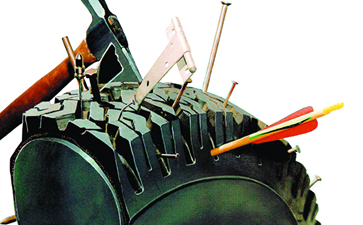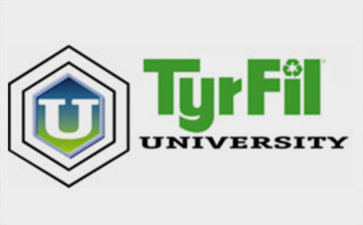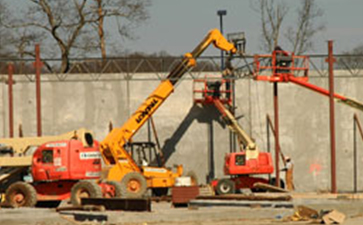New ANSI Requirements for Aerial and Lift Access Equipment Brings New Opportunities for Filled-Pneumatic Tires
The new changes published by the American National Standards Institute (ANSI) and the Canadian Standards Association (CSA)—the governing standards bodies overseeing the design and use of aerial and lift access equipment across North America—have opened up new opportunities for the use of tire fill technology. Developed with the aim of enhancing the performance, safety and training applications around this essential equipment, the new ANSI “A-92” standards have instituted broad reaching changes. Chief among them has been a shift in nomenclature. Formerly called “aerial work platforms” (AWPs), this equipment, under the new standards, will now be called “mobile elevating work platforms” (MEWPs).
Under the new standards, MEWPs will also be classified differently. Group A machines (informally known as “scissor lifts”) and Group B equipment (“booms”) now have new Type 1, 2, and 3 classifications to denote new usage guidelines, especially surrounding elevation and safety standards. Additional upgraded requirements have been instituted regarding theoretical and practical training protocols, and safe equipment use.
But many of the most significant changes revolve around a series of machine design adaptations. According to the ANSI guidelines, the goal of the new machine design requirements is to “serve as a guide for manufacturers, remanufacturers, engineers, and designers of MEWPs to ensure the machines being built are compliant.” Key new development areas address issues related to Load Sensing, Tilt Sensing Requirements, Wind Force Requirements, Entrance Gates, Platform Railings and Machine Markings, and Manuals.
While these are all important shifts, the most relevant change for our industry are the new requirements specifically surrounding tire technology. As part of the new Stability Calculations & Tests category, most rough terrain equipment will no longer be allowed to operate with air-filled tires – only foam-filled or solid tires will be acceptable as part of the new stability testing guidelines. According to the ANSI White Paper, “…you can expect to see foam filled only (no air-filled tires) on the vast majority of RT scissors and RT booms.” Additionally, because the availability of air-filled tires will now be limited, operators will need to take this into account when planning for job sites with soft ground, sand, and gravel areas.
Carlisle’s TyrFil™ Flatproofing, referred to as “foam-fill” in many of the ANSI materials, meets the latest MEWP standards. TyrFil has been a prevalent component in the OEM MEWP sector and fully complies with the latest ANSI requirements. End users and rental companies can also access the same standards via the TyrFil aftermarket network. While solid tires will still be allowed under the new requirements, when it comes to machine drivability and weight issues, tire fill technology provides increased traction and stability when compared to the solid tire option. This is especially the case when it comes to softer ground, sand, or gravel surfaces, and uneven or sloped terrain. When the tire is punctured on the ground while an operator is in the basket, it can create a catastrophic safety hazard.
Overall, tire fill technology offers innumerable advantages. TyrFil is comprised of polyurethane liquid fill that is pumped into pneumatic tires to replace air with a resilient, synthetic elastomer core. TyrFil eliminates dangerous and costly tire flats on off-the-road (OTR) equipment and prevents unanticipated blowouts. Even in the most hazardous environments, tires filled with TyrFil remain virtually impervious to flats on the job. TyrFil enables equipment to literally glide over glass, nails, rocks, rebar, and other sharp objects typically found in debris-cluttered worksites.
While the initial cost for tire fill will be more than a traditional air-filled pneumatic tire, lift and access operators will invariably save substantial overhead throughout the life of their tire investment, making these protocol changes a win-win for the whole industry. In terms of ANSI compliance and the new A92 requirements, Carlisle TyrFil stands at the ready to accommodate the needs of the entire sector. Tire manufacturers are consistently developing new sizes and profiles in accordance with the new protocols—and, as a category, the tire fill industry is ready to fulfill the new market demand.
For more information about tire technology for lift and access machines, feel free to reach out to the Carlisle TyrFil team.


